The Green Deal is one of the most ambitious policies of the EU which aims to make the bloc go green by the year 2050. The law involves holistic cross-sectional policy structures that can align all industries right from manufacturing to finance to ensure that the industry is well aligned to make the industry sustainable. The law aims to cut emissions by 55 per cent by 2030 which aims to create a cost-effective and socially fair green transition for the industries in the economy.
The Circular Economy Action Plan (CEAP) under the European Green Deal focuses on promoting sustainable resource use in the textile industry. It encourages recycling, reuse, and minimising waste to transition towards a circular economy. Key measures include improving product design for sustainability, supporting recycled material use, and reducing the environmental impact of textiles. The CEAP is closely aligned with the EU Textile Strategy, addressing specific sustainability challenges in the sector. There are 5 million tonnes of clothes discarded around 12 kg per person. With only 1 per cent of clothes recycled, the EU policy wants to put fast fashion out of the economy. The EU also wants to introduce Extended Producer Responsibility (EPR), which will make the producers responsible for considering the full responsibility of the product buyback, reuse, and recycling of the clothes collected. Companies like H&M for example are already taking steps towards the same by incorporating innovative technologies like Looop among many the policies have the potential to make the textile industry across the world more responsible and innovative in recycling the used and waste textiles in the manufacturing processes.
Innovative Technologies for Recycling Disposed Clothing
Currently, disposed clothing is often exported as second-hand garments or downcycled, with technologies for recycling clothing into new apparel still in development due to the diversity of fibre types used in production. One promising approach that many nations are considering is closed-loop recycling. This method aligns with the principles of a circular economy, which promotes the recycling, reusing, upcycling, or downcycling of all products.
Despite its potential, the industry’s capacity for circular economy practices remains underutilised, largely due to insufficient investment and a lack of strong government support. Nevertheless, some companies and organisations are pioneering closed-loop recycling methods on a pilot basis. For example, initiatives in Los Angeles are actively implementing circular economy principles. These efforts include staff training and program design, supported by consultants. Other apparel companies are also exploring these methods, and their effectiveness will be evaluated through life cycle analyses.
Below is a brief overview of the methods being adopted by these companies:
Understanding the Closed-Loop Recycling Method
Closed-loop recycling is a sustainable production approach where all materials and components used in garment manufacturing are either sourced from recycling collections or collected through take-back schemes. A crucial requirement of this method is maintaining the quality of the apparel. For a garment to be effectively recycled, it must produce a new garment of comparable quality to the original.
To date, the only successful pilot has been conducted for polyester garments, which are the most prevalent fibre type globally. Some brands are recycling their post-consumer waste into new garments, but no company or country has yet developed a foolproof solution for achieving completely recycled garments.
Wear2wear loop method
The initiative involves leading European brands collaborating across the textile value chain to produce apparel from recycled textile materials. This approach integrates sustainability principles, including transparency and traceability, ensuring that the clothing can be fully recycled at the end of its life cycle. The process encompasses all eight components of the textile value chain, from fibre production to washing and disposal.
A life cycle analysis of the Wear2Wear (W2W) method indicates that while it is like traditional linear production methods, it introduces significant environmental benefits. Unlike linear production, which uses petroleum to produce polyester fibre, W2W recycles PET bottles in the initial stage. Although a direct comparison between production systems is complex, the environmental advantages are clear. W2W reduces environmental pollution by 25 per cent compared to linear methods and diminishes human health risks by over 50 per cent. It also decreases land use by 20 per cent and water use by 45 per cent compared to traditional methods.
Greenhouse gas emissions are lower with W2W due to the use of recycled materials, which cuts waste and emissions associated with virgin materials. Throughout all stages of W2W, emissions are reduced compared to the linear production system. Specifically, W2W cuts greenhouse gas emissions by 33 per cent, lowers health risks by 51 per cent, and lessens land resource pressure by approximately 15 per cent. The analysis also shows a significant reduction in raw material and energy usage.
However, the overall energy usage and environmental impact vary depending on the type of fibre recycled and the specific apparel produced. The system's efficiency is expected to improve with further research into material types and their impact on the recycling process. Each recycling method should be assessed individually, as comparing them directly to linear production will become increasingly ambiguous due to differences at each production stage.
Energy Generation
Although renewable energy sources are increasingly being adopted for textile manufacturing, the transition is still gradual. Globally, most of the textile production continues to rely on natural gas and thermal energy. Currently, coal and oil remain dominant in energy generation, with renewable energy sources accounting for less than 10 per cent of the total. This highlights the urgent need for countries to accelerate the adoption of renewable energy to reduce the environmental impact of textile manufacturing.
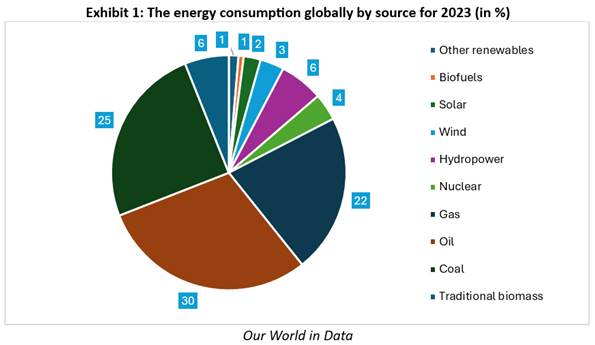
The textile manufacturing process is highly energy-intensive, with each stage requiring substantial energy. The energy consumption can be broken down as follows:
• Spinning: Approximately 25-30 kWh per 100 kg of yarn produced.
• Weaving: Around 25-30 kWh per 100 kg of fabric produced.
• Dyeing and Finishing: Between 200-300 kWh per 100 kg of fabric processed.
While these figures are approximate and may vary by country based on machinery and processes, there is a growing need to adopt renewable energy sources—such as solar, wind, and hydroelectric power—to optimise both costs and environmental impact. For instance, in Bangladesh, the ongoing energy crisis significantly contributes to high production costs. Therefore, there is a pressing need for policies that support the development and integration of renewable energy sources.
In a circular economy for fashion, energy is sourced from renewable resources, reducing reliance on finite resources and enhancing system resilience. This approach ensures that resources are kept within the system, with necessary inputs derived from renewable sources. For example, renewable feedstocks are used for plastic-based fibres, and fossil-fuel-based fertilisers or pesticides are avoided in the cultivation of biologically based inputs. Additionally, the circular economy model supports this transition by minimising overall energy and resource consumption. However, the current reality often falls short of this ideal. The following section outlines the energy capacity across different countries.
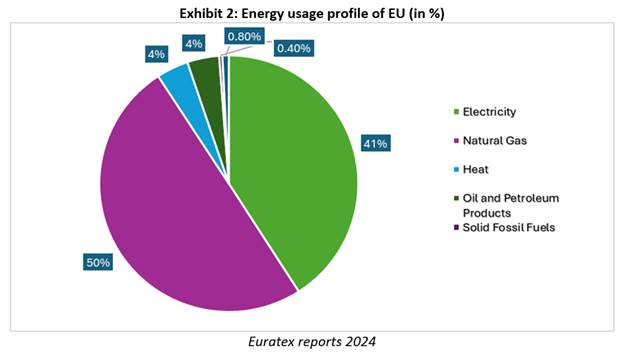
EU for example, which is one of the blocs to promote sustainability policies dominates natural gas, which is also one of the most unsustainable fuels along with coal. Therefore, there must be some balance between what is to be announced as a policy, and what is the actual on-ground situation. If looked carefully India, Bangladesh, and Viet Nam have significantly adopted solar energy. Thus, even though there might be a gap in textile recycling policies in these Asian textile majors, in terms of energy; it is one of the most concerning issues in the world in terms of natural resource depletion.
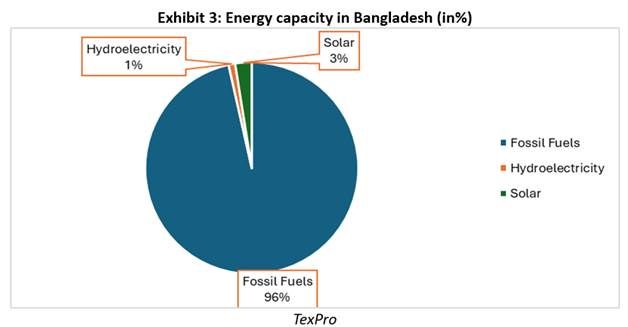

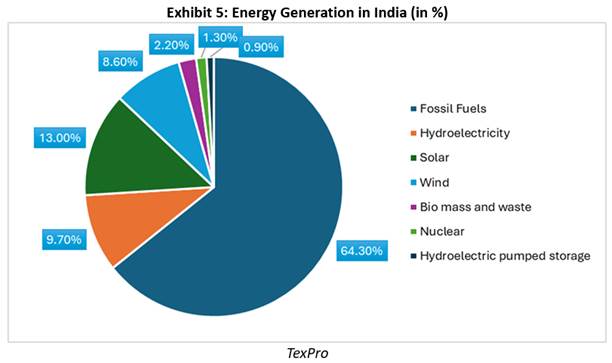
Asian Initiatives in Alternative Energy Production and Their Impact on Exports
Textile-producing nations in Asia have set targets for sustainable energy usage. India aims to generate around 500 gigawatts (500,000 megawatts) of renewable energy by 2030, according to the Indian Central Electricity Authority. Currently, India relies on coal for about 48 per cent of its energy. Vietnam relies on fossil fuels for 55 per cent of its energy generation, while Bangladesh is highly dependent on natural gas, with 98 per cent of its energy from fossil fuels. Therefore, these countries must increase renewable energy generation. Vietnam has a target of generation of 4000 MW of Solar energy by the year 2025, whereas Bangladesh aims to generate 2.3 GW of solar energy by 2030.
According to the Asia Natural Gas and Energy Association, Vietnam heavily relies on coal for energy. Solar energy generation in Vietnam has stagnated, yet there is a strong correlation between energy generation and apparel exports. Energy generation is forecasted to increase by an average of 1.5 per cent annually until 2029, which could boost exports. Cost-efficient production will support this surge, potentially reaching the $70 billion export target set by VITAS by 2030. Under pressure from importing countries, Vietnam has increased solar power generation, with garment factories increasingly using solar energy to meet demands from markets like the European Union. However, looking at the antithesis of the EU in terms of energy generation, Vietnam and other Asian countries seem to be doing better.
Both India and Bangladesh have made significant progress in solar energy generation, with India's vast land and ambitious targets making it a major player in the global market. Both countries stand to gain from reduced reliance on fossil fuels, promoting sustainability, cost savings, and economic growth through solar energy investment.
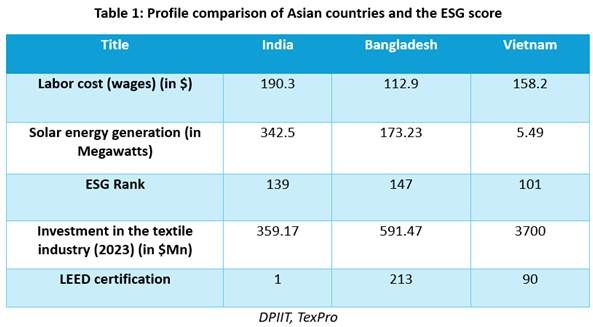
Even though the countries have their progress in terms of the ESG scores which is more on the weaker side, the energy generation in these countries in terms of renewable energy stays robust. And therefore, the Asian countries with some push may implement more policies encouraging sustainability if given a proper fiscal space for investments in the sector.
The Way Forward
While the EU and the US have established laws to promote sustainability, Asian nations are also making significant strides in energy generation and sustainability. These countries are working on implementing laws and policies to encourage sustainability throughout the textile value chain. However, a major challenge remains the informal nature of waste collection and the inadequately integrated recycling systems, which require a complete overhaul.
To ensure that recycling systems function effectively, substantial structural reforms are needed. Many Asian countries already have the foundational elements of their textile systems in place. The key is to formally recognise and enhance the visibility of these value chains, making them more appealing to institutions, investors, and banks. This would facilitate better investment and access to financial resources, supporting more efficient and sustainable recycling practices.
The push for sustainability has ushered in a wave of creative destruction, presenting an opportunity for Asian countries to take a leading role. However, to realise this potential, it is crucial to address systemic bottlenecks and bridge the gap between consumer needs and producer offerings.
Currently, there is a significant policy gap: while the EU is implementing stringent regulations, many Asian apparel producers face structural challenges that hinder similar progress. This disparity creates a global impasse. Therefore, increased coordination between stakeholders—namely, producers and consumer countries—is essential to develop and implement more responsible and effective policies.









Comments